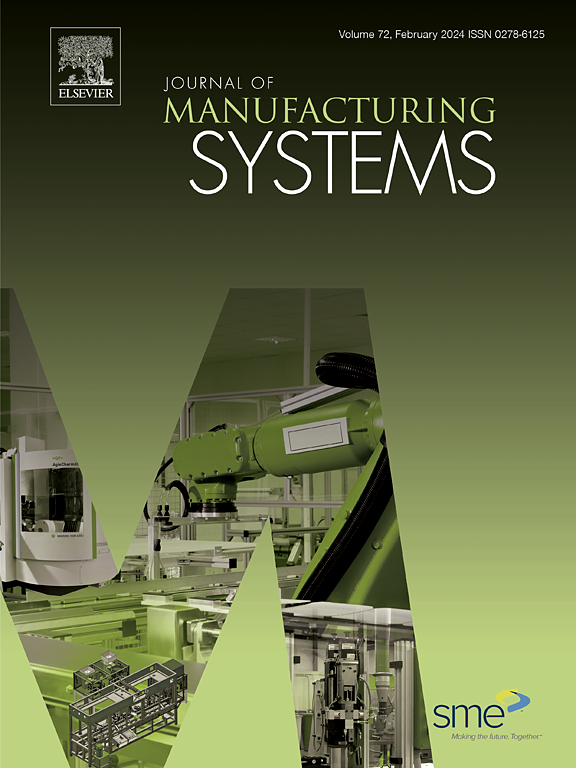Enhancing sustainability of human-robot collaboration in industry 5.0: Context- and interaction-aware human motion prediction for proactive robot control
IF 14.2
1区 工程技术
Q1 ENGINEERING, INDUSTRIAL
引用次数: 0
Abstract
Industry 5.0 (I5.0) marks a shift towards human-centric, sustainable, and resilient production systems, with Human-Robot Collaboration (HRC) contributing to these goals. Achieving sustainability of HRC, encompassing economic, environmental, and social dimensions, remains challenging to ensure safety, efficiency, and adaptability. Human Motion Prediction (HMP) can address these challenges by enabling robots to anticipate human actions and respond proactively. However, existing HMP studies often neglect to incorporate contextual and interaction-based information. The practical applicability of HMP in industrial settings requires further demonstration. Therefore, this study aims to apply context- and interaction-aware HMP to enhance sustainability of HRC in I5.0. A motion capture system collects human motion data, while a camera tracks object position as contextual information. Human-Object Interaction (HOI) is identified for HMP. A transformer model is applied for HMP based on integrated context and interaction data. Additionally, the applicability of HMP in industrial settings is demonstrated by a power transformer assembly. Two additional cases are applied for validation. Results show that object recognition achieved 98 % accuracy. The identified interaction periods are effective in enhancing HMP performance. HMP with context and interaction data achieves an Average Displacement Error (ADE) of 0.07 m and a Final Displacement Error (FDE) of 0.10 m. The demonstration results suggest that the HMP enabled proactive robot control, contributing to safer, more efficient, and adaptive production. The findings of this research contribute to enhancing the sustainability of HRC in I5.0, with potential benefits for environmental efficiency, worker safety, and productivity in industrial settings.
增强工业5.0中人机协作的可持续性:用于主动机器人控制的上下文和交互感知的人类运动预测
工业5.0 (I5.0)标志着向以人为中心、可持续和有弹性的生产系统的转变,人机协作(HRC)有助于实现这些目标。实现HRC的可持续性,包括经济、环境和社会层面,在确保安全性、效率和适应性方面仍然具有挑战性。人类运动预测(HMP)可以通过使机器人预测人类的行为并主动响应来解决这些挑战。然而,现有的HMP研究往往忽略了结合上下文和基于交互的信息。HMP在工业环境中的实际适用性需要进一步论证。因此,本研究旨在应用情境感知和交互感知的HMP来增强I5.0中HRC的可持续性。动作捕捉系统收集人体运动数据,而摄像机跟踪物体位置作为上下文信息。针对HMP,确定了人-物交互(HOI)。将基于集成上下文和交互数据的变压器模型应用于HMP。此外,HMP在工业环境中的适用性通过电力变压器组件来证明。另外两个案例被用于验证。结果表明,目标识别准确率达到98% %。确定的交互周期对提高HMP性能是有效的。具有上下文和交互数据的HMP得到的平均位移误差(ADE)为0.07 m,最终位移误差(FDE)为0.10 m。演示结果表明,HMP实现了机器人的主动控制,有助于更安全、更高效和自适应生产。本研究的结果有助于提高I5.0中HRC的可持续性,在工业环境中对环境效率、工人安全和生产力有潜在的好处。
本文章由计算机程序翻译,如有差异,请以英文原文为准。
求助全文
约1分钟内获得全文
求助全文
来源期刊

Journal of Manufacturing Systems
工程技术-工程:工业
CiteScore
23.30
自引率
13.20%
发文量
216
审稿时长
25 days
期刊介绍:
The Journal of Manufacturing Systems is dedicated to showcasing cutting-edge fundamental and applied research in manufacturing at the systems level. Encompassing products, equipment, people, information, control, and support functions, manufacturing systems play a pivotal role in the economical and competitive development, production, delivery, and total lifecycle of products, meeting market and societal needs.
With a commitment to publishing archival scholarly literature, the journal strives to advance the state of the art in manufacturing systems and foster innovation in crafting efficient, robust, and sustainable manufacturing systems. The focus extends from equipment-level considerations to the broader scope of the extended enterprise. The Journal welcomes research addressing challenges across various scales, including nano, micro, and macro-scale manufacturing, and spanning diverse sectors such as aerospace, automotive, energy, and medical device manufacturing.
 求助内容:
求助内容: 应助结果提醒方式:
应助结果提醒方式:


